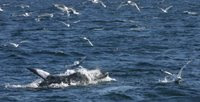 Saturday… though on the ship all the days blend together, and it feels like we’ve been on here forever! Yesterday, amongst many activities, Inigo 'Jones' Martinez (FRS) retrieved his lander from the top of the bank. The lander (shown with Inigo in the picture to the left) has a camera & flash attached, and is positioned so it floats a few metres over a large weight with mackerel bait attached to it (see second photo - some of the mackerel bait is wrapped in plastic bags that disolve over time, so that there is bait available to the fish over a longer period of time).
Saturday… though on the ship all the days blend together, and it feels like we’ve been on here forever! Yesterday, amongst many activities, Inigo 'Jones' Martinez (FRS) retrieved his lander from the top of the bank. The lander (shown with Inigo in the picture to the left) has a camera & flash attached, and is positioned so it floats a few metres over a large weight with mackerel bait attached to it (see second photo - some of the mackerel bait is wrapped in plastic bags that disolve over time, so that there is bait available to the fish over a longer period of time).  The camera is programmed to take photos every minute. This way we can see what fish & other critters are on the sea bed, and how this changes with tidal speed (well, ideally). The photo below shows a photo of a whiting (which in the next photo swims off with a whole mackerel bait! Thief!), and lots of hermit crabs, and a very sandy bottom. In other photos Inigo identified a gurnard, haddock, little shoals of small fish, starfish & brittle stars, and snails. It’s fun to see what’s down there!
The camera is programmed to take photos every minute. This way we can see what fish & other critters are on the sea bed, and how this changes with tidal speed (well, ideally). The photo below shows a photo of a whiting (which in the next photo swims off with a whole mackerel bait! Thief!), and lots of hermit crabs, and a very sandy bottom. In other photos Inigo identified a gurnard, haddock, little shoals of small fish, starfish & brittle stars, and snails. It’s fun to see what’s down there! Picture above shows a whiting & lots of hermit crabs heading for the mackerel bait taken at MS2 around 70m depth
Picture above shows a whiting & lots of hermit crabs heading for the mackerel bait taken at MS2 around 70m depthMeanwhile, science life continued (I realise I still haven’t talked about the activities of over half the scientists – so much going on!) – the main activity yesterday was the tracking of the dye released into the thermocline two days ago. So a large chunk of yesterday was spent towing the scanfish (that moves up and down the water column measuring temperature & salinity with depth – and on this one a fluorometer that was able to measure the amount of dye in the water) around the area where the dye had been released to track its progress. This is essentially to determine how turbulent mixing at the thermocline disperses material (whether plankton, nutrients, etc.). The dye had spread in a plume of around 8km long – which was interesting :o) Mark Inall, Claire Neil & John Beaton (SAMS) sat poring over the computer as the scanfish sent live dye readings to their computer (nifty programming on Claire’s part), and displayed a spatial map of the dye spread.
As to today, I escaped to freedom! We launched the rescue boat to go out and try my vertical hydrophone array. This has underwater microphones positioned at 4 different depths through the water column & is hung over the side of the small boat to record the sounds of … well… hopefully feeding dolphins. What I’d like to do is to work out how deep the dolphins are diving when they’re feeding, to see if they’re feeding at the same depth at which the fish are found on the echosounder, or to the depth of the thermocline. Today we were just testing the hydrophone, and certainly it was all peaceful down there in the deep sea (I can get down to 65m depth)… all I recorded was the distant ping of the ship echosounder. After around 30 minutes drifting on the swell, we all turned a bit green – Peter (1st Mate & boat driver), Steve & I. So since it was all working & nothing to be heard apart from the gentle ping of the ship, we returned to our home. I, for one, was glad to be back on the more stable RRS James Cook… home for now.



No comments:
Post a Comment